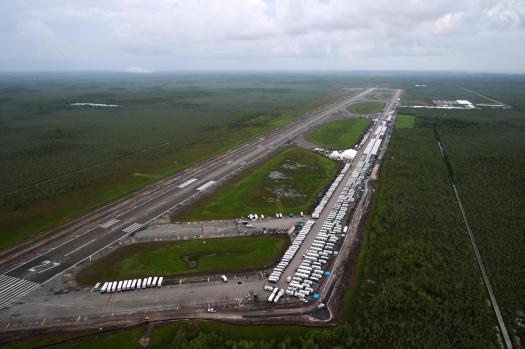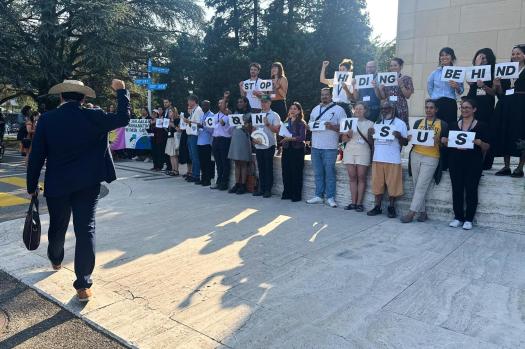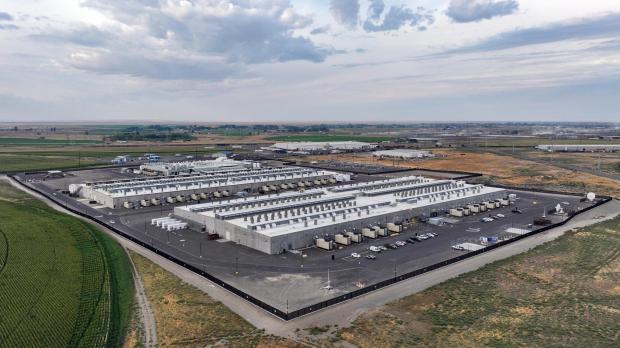There are still concerns regarding the safety of the detainees and workers at Alligator Alcatraz, the temporary tent city built to keep migrants in the middle of the Everglades, as Florida approaches storm season.
In particular, anyone residing in a tent in the Everglades could face fatal circumstances due to flooding, a storm coming from the Gulf, and quick storm intensification.
The majority of the information in a 33-page paper that the state provided on Wednesday that described the strategy for a full-scale evacuation of the site was blacked out due to heavy redaction.
Activation Procedures, a section that might have described how and when the state would decide to evacuate the facility, was completely blacked.
At a recent news conference, Kevin Guthrie, head of Florida’s Division of Emergency Management, made it clear that the temporary buildings used to house detainees are capable of withstanding a Category 2 storm with sustained winds of between 96 and 110 miles per hour. “I can assure you that the hurricane experts have everything covered,” Guthrie added.
Hurricane classifications do not account for tornadoes, storm surge, quick intensification, or storm travel speed; they only rate wind speed.
Hurricanes can hit Alligator Alcatraz, which is located inside Big Cypress National Preserve, from almost any angle.
A tropical storm might become a Category 3 hurricane in a single day due to the recent increase in storm intensity.
Therefore, considerations other than storm classification would have to be incorporated into any evacuation decision.
In order to learn more about the duration of an evacuation, the quantity of buses required to transport inmates, and the origin of those vehicles, the South Florida Sun Sentinel reached out to Florida’s Division of Emergency Management. It also questioned how the state’s evacuation strategy took storm surge, floods, and rapid intensification into account.
As of now, there has been no response from the emergency management section.
Here are some of the factors that make Alligator Alcatraz especially vulnerable.
In recent decades, hurricanes have become more intense, making it more challenging for emergency personnel to determine risk and plan evacuations. Any storm that increases its maximum sustained wind speed by 35 mph or more in a 24-hour period is considered to be rapidly intensifying, according to the National Hurricane Center.
Within 24 hours of reaching shore, Hurricane Helene in 2024 accelerated from Category 1 to Category 4, reaching sustained winds of 140 mph.
Additionally, Hurricane Lee in 2023, thankfully far out to sea, went from a Category 1 to a Category 5 in a single day. In less than twenty-four hours that same year, Hurricane Idalia went from a tropical storm to a Category 4 hurricane.
Hurricanes are intensifying more quickly now than they did in the past, according to a 2023 study. Between 1980 and 2020, the number of hurricanes that intensified quickly in coastal areas (within 250 miles of the coast) increased worldwide.
According to the study, the trend was caused by rising sea surface temperatures brought on by climate change. Hurricanes are fueled by the warmer water temperatures. Rapid intensification requires sea surface temperatures of at least 80 degrees.
What does Alligator Alcatraz have to gain from that? In a day, a tropical storm that appears safe and moves at a reasonably rapid 25 mph could traverse 600 miles and intensify into a fatal Category 4 storm.
This begs the question: even if an oncoming system is only a tropical storm, how many days out does the state need to issue an evacuation order?
Fortunately, depending on the environment a cyclone is entering, experts can forecast the probability of quick intensification. According to National Weather Service meteorologist George Rizzuto, the primary causes include wind shear, sea surface temperature, the ability of a storm to organize and stack vertically, and the atmospheric moisture profile.
The storm would be weakened by wind shear and dry air, but it would be strengthened by hot water and calm, humid air.
Another effect is a storm’s width. Compact storms can spin up more quickly, resembling a spinning figure skater who pulls their arms in to rotate faster, whereas wide, sprawling storms take longer to intensify.
Rapid intensification is also influenced by a storm’s posture, whether it is inclined or upright. The likelihood of an upright storm getting stronger is higher.
Sea-surface temperatures in the Atlantic at the end of July are warmer than typical compared to the average since 1985, but not as abnormally hot as those in 2023 and 2024 for this time of year, according to the National Oceanic and Atmospheric Administration.
Depending on the direction of the hurricane, Alligator Alcatraz is 25 to 50 miles inland, but that doesn’t mean it’s safe.
Hurricane Helene in 2024 continued to be a hurricane 200 miles from the coast in central Georgia.
Additionally, hurricane-force wind gusts reached the mountains of western North Carolina, 350 miles inland, according to NOAA.
About 20 miles south of Alligator Alcatraz, Hurricane Andrew of 1992 sliced across the Everglades, yet local wind speeds were still as high as Category 5, or 160 mph.
For two days, the storm isolated the Miccosukee tribe from the outside world.
“The highways were one of our biggest issues,” Tribal Police Chief Tony Zecca told the Sun Sentinel in 1992. Trees had fallen and obscured everything. I was terrified that we wouldn’t be able to call for aid in the event of a medical emergency.
According to the Sun Sentinel at the time, they lacked radios, power, and telephones. Outside agencies could not be reached, not even by the tribal police.
Guthrie and Gov. Ron DeSantis have stressed that water kills more people than wind during and after storms in earlier press conferences alerting people to leave before hurricanes struck. Both rain and storm surge have the potential to flood Alligator Alcatraz.
Furthermore, storms can approach from nearly any angle.
1992 s Hurricane Andrew barreled in from the east coast and pummeled the area; in 2005, Hurricane Wilma shot in from the Gulf, causing wind gusts of93 mph near Alligator Alcatraz; and in 2006,Ernesto came in from the southon a track that took it almost directly over the site.
Growing up close to the Alligator Alcatraz facility, Curtis Osceola, senior executive policy adviser for the Miccosukee Tribe, has voiced his opposition to the incarceration location.
According to Osceola, Big Cypress is a rain-driven system, meaning that when it rains a lot, the water builds up before moving south. Floodwaters from the Everglades’ southern flow would be directed onto Alligator Alcatraz, where the Tamiami Trail serves as a dam to store water.
Osceola remembers how Hurricane Irma in 2017 slammed over Big Cypress from the south, dumping up to 20 inches of rain. According to Osceola, the runway—where the detainee tents are located—is sort of washed away by the water.
The FAA claims that Alligator Alcatraz’s elevated runways are 12.7 feet above sea level, which is marginally higher than the surrounding swamp, which the US Geological Survey estimates is between 7 and 9 feet above sea level.
Storm surge, which happens when hurricane winds force water up into coastal communities, is the other water hazard.
In Florida, storm surge killed about three times as many people as wind during Hurricane Helene. The shallower the coastal water, the more a hurricane can pile it up. That s why the Gulf coast is more susceptible than the deeper Atlantic coast.
The National Weather Service s Rizzuto said that a hurricane coming in from the Gulf could pose a storm-surge risk for the facility.
If a storm was coming from the west side, near Flamingo, you d have a strong westerly component to the wind all across Collier County, Rizzuto said. So you d see all that ocean water and fresh water pushing toward the interior.
Another less likely scenario is that a storm approaching from the east would push Everglades sheet flow west, toward Alligator Alcatraz. Rizzuto said that was hypothetically possible, but he was more concerned with storm surge from a hurricane approaching from the Gulf side.
Alligator Alcatraz could be at risk from strong tornadoes, even from a hurricane that makes landfall 140 miles away.
Last year, Hurricane Milton blew in from the Gulf south of Tampa and cut across the state.
The outer bands of the stormspun off 19 tornadoes, many of which occurred in South Florida, 90 to 140 miles away from the eye.
Several of those twisters produced wind speeds far greater than the 110 mph Category 2 wind that the Alligator Alcatraz tents are designed to withstand. One of them had peak winds speeds of 155 mph and killed six people near St. Lucie.
Evacuating 1,000 or more detainees plus staff from the remote Everglades is no small task.
Osceola, who has worked as a public defender and witnessed inmate transport protocols, is concerned about the complications.
Detainees are going to need to be shackled, they re going to need security on the (bus) windows, they re going to need guards for each bus ride, and they re going to need a facility to place them temporarily while the storm passes, he said.
The disaster plan lists five potential alternate facilities in the event of an evacuation. Those sites are blacked out, presumably for security reasons.
Florida knows how to respond to crises, Guthrie said. We specialize in response and recovery, acting fast, and most importantly, logistics management. That same speed, precision and discipline has been applied here at Alligator Alcatraz.
The state has evacuated plenty of prisons before.
In 2023, the Department of Correctionsevacuated 4,000 prisonersfrom 35 facilities statewide ahead of Hurricane Idalia. And Milton prompted the evacuation of5,460 inmatesfrom 28 facilities.
When we have 1,000 (Alligator Alcatraz detainees) I need to make sure we have room for 1,000 (at other sites), said Guthrie at the news conference. When we go to 2,000, I need to make sure we have room for 2,000.
Guthrie said that in an evacuation scenario, such as a major hurricane (Category 3 or higher), it s incumbent upon the Florida Division of Emergency Management with our law environment partners to be able to do that, Guthrie said. So we are constantly looking at what we can do when we get to a certain (hurricane) level, where we re going to go.
Though the Alligator Alcatraz site currently holds about 1,000 detainees, Guthrie said it will eventually be able to hold 4,000. As our capacity increases, we continue to identify contingency plans to ensure we are ready for hurricane season, Guthrie said.
Hurricane season runs through Nov. 30.
Bill Kearney covers the environment, the outdoors and tropical weather. He can be reached [email protected]. Follow him on Instagram@billkearneyor on X@billkearney6.












